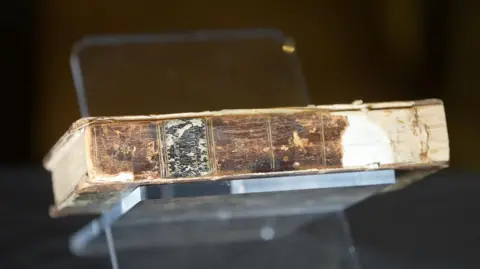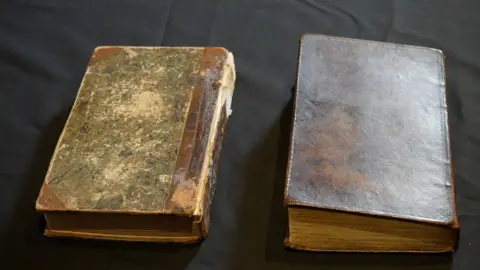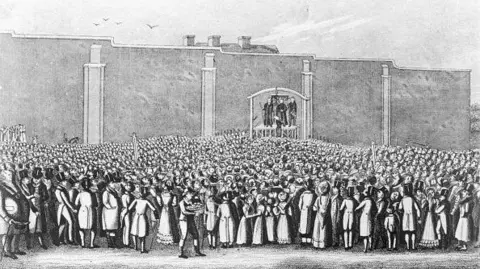Book bound in human skin found in museum office
 BBC/Jamie Niblock
BBC/Jamie NiblockA book bound in the skin of one of the UK's most notorious murderers is to go on display after being found in a museum's office.
The work is understood to be made using the skin of William Corder, the man convicted of killing Maria Marten in the Red Barn Murder in 1827, and will go on display alongside a similar item at Moyse's Hall Museum in Bury St Edmunds, Suffolk.
Dan Clarke, heritage officer, said the books had an "incredibly important" historical value and that he had never had a complaint about the first being on display.
However, Terry Deary, author of Horrible Histories, described them as "sickening artefacts", adding: "These are two books I'd like to burn."
 BBC/Jamie Niblock
BBC/Jamie NiblockThe story of the 1827 murder in Polstead, Suffolk, shocked Georgian Britain.
Since then, it has been the subject of many films, books, plays and folk songs.
The most commonly told version is that Corder had been having an affair with Miss Marten.
He told her to meet him at the Red Barn, a local landmark, saying they would run away to Ipswich to get married.
But Corder shot and killed Miss Marten, burying her in the barn.
He was eventually caught and publicly executed on 11 August 1828.
His body was dissected and part of his skin was used to bind a book telling the story of his trial.
 Getty Images
Getty ImagesThis book was put on display at the museum in 1933.
But recently curators were looking through the museum's catalogue and realised there was a second book that had been overlooked.
It had been donated decades ago by a family with close connections to the surgeon who anatomised Corder's body.
The book was located, not in the museum stores, but on a bookshelf in the office, next to other books bound in more traditional materials.
Mr Clarke said: "We get things called museum losses, and it tends to be from the last century - things that have not been seen for a couple of decades.
"This would be considered a museum loss which has been found."
Unlike the first Corder book, the skin is only on the book's binding and corners.
Covering books in human skin is known as anthropodermic bibliopegy.
Books were often created in the 19th Century to punish executed prisoners or by doctors who wanted a keepsake.
 Getty Images
Getty ImagesDeary, whose Horrible Histories series have sold millions around the world and been turned into a TV franchise, said Corder had been convicted on circumstantial evidence and suffered terribly as a result.
On the museum items, he said: "I know you're not supposed to burn books but quite honestly these are such sickening artefacts.
"What was worse than the hanging was the thought that their body would be dissected after death, and this is an extension of that."
In March 2024, Harvard University removed the skin binding from a 19th Century book in its library "due to the ethically fraught nature of the book's origins and subsequent history".
But staff at Moyse's Hall said that would not happen to either of its books, which are now on display together.
Mr Clarke said: "We see human remains in every museum across the country."
In his 11 years at the museum, he said, there had not been a single complaint about the first book, but there had been concerns raised about mummified cats being displayed as part of a witchcraft exhibit.
Heritage assistant Abbie Smith got to hold the books on her first day in the job and said they felt "like a real book".
"If you did not tell people it was bound in human skin, I do not really think you would realise," she said.
"It is also rather humbling to have something like that in the collection."
Follow Suffolk news on BBC Sounds, Facebook, Instagram and X.
